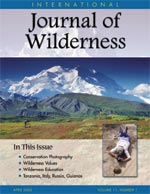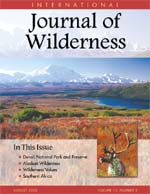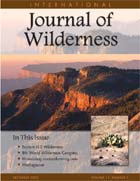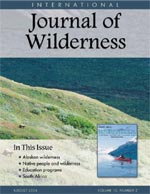 This issue of the Journal starts with an editorial perspective from Vance Martin on wilderness as a bipartisan cause, and announcing the International Conservation Caucus Foundation (ICCF). Joseph E. Mbaiwa and Onaletshepho I. Mbaiwa contribute an article on the effects of veterinary fences on wildlife population in the Okavango Delta region of Botswana.
This issue of the Journal starts with an editorial perspective from Vance Martin on wilderness as a bipartisan cause, and announcing the International Conservation Caucus Foundation (ICCF). Joseph E. Mbaiwa and Onaletshepho I. Mbaiwa contribute an article on the effects of veterinary fences on wildlife population in the Okavango Delta region of Botswana.
 In this issue of the Journal, Cristina Mittermeier provides a call to action and mission for all conservation photographers. In her stewardship article, she announces the first ever Conservation Photography symposium, which convened at the 8th World Wilderness Congress in Anchorage, Alaska, 2005 and lead to the formation of the International League of Conservation Photographers. Gregory Brown and Lilian Alessa contribute an article on wilderness values in Alaska, based on GIS-based study methods.
In this issue of the Journal, Cristina Mittermeier provides a call to action and mission for all conservation photographers. In her stewardship article, she announces the first ever Conservation Photography symposium, which convened at the 8th World Wilderness Congress in Anchorage, Alaska, 2005 and lead to the formation of the International League of Conservation Photographers. Gregory Brown and Lilian Alessa contribute an article on wilderness values in Alaska, based on GIS-based study methods.
 This issue of the journal focuses specifically on Alaska wilderness, in preparation for the 8th World Wilderness Congress, Anchorage, Alaska 1005. Miki Collins and Julie Collins write about the traditional way of life at Denali and how subsistence lifestyles can go hand-in-hand with protecting for wilderness values. Stephen F. McCool, winner of the Chief’s Excellence in Wilderness Stewardship Award, details his work in the Bob Marshal wilderness.
This issue of the journal focuses specifically on Alaska wilderness, in preparation for the 8th World Wilderness Congress, Anchorage, Alaska 1005. Miki Collins and Julie Collins write about the traditional way of life at Denali and how subsistence lifestyles can go hand-in-hand with protecting for wilderness values. Stephen F. McCool, winner of the Chief’s Excellence in Wilderness Stewardship Award, details his work in the Bob Marshal wilderness.
 Two articles in this issue of the journal address natural disasters and the implications for wilderness areas, specifically focused on the impacts of the 2004 hurricanes that devastated many national forest lands in Florida. Russell Mittermeier, Frank Hawkins, Serge Rajaobelina and Oliver Landgrand contribute an article focused on the Biodiversity Hotspot of Madagascar and conservation efforts there.
Two articles in this issue of the journal address natural disasters and the implications for wilderness areas, specifically focused on the impacts of the 2004 hurricanes that devastated many national forest lands in Florida. Russell Mittermeier, Frank Hawkins, Serge Rajaobelina and Oliver Landgrand contribute an article focused on the Biodiversity Hotspot of Madagascar and conservation efforts there.
 This issue of the IJW salutes forty years of the US Wilderness Act. John Hendee and Chad Dawson contribute a special editorial perspective on this significant milestone. In the education and communication section, Dawson and Hendee also provide an overview of wilderness-related courses at US Colleges and Universities and Suzanne Caswell and Rob Meltzer introduce the Wilderness Therapy Symposium Series at Naropa University. John Shultis reviews the book, “Wilderness: Earth’s Last Wild Places,” by Russell A. Mittermeier et al.
This issue of the IJW salutes forty years of the US Wilderness Act. John Hendee and Chad Dawson contribute a special editorial perspective on this significant milestone. In the education and communication section, Dawson and Hendee also provide an overview of wilderness-related courses at US Colleges and Universities and Suzanne Caswell and Rob Meltzer introduce the Wilderness Therapy Symposium Series at Naropa University. John Shultis reviews the book, “Wilderness: Earth’s Last Wild Places,” by Russell A. Mittermeier et al.
 This issue of the IJW focuses on Alaska, in preparation for the 8th World Wilderness Congress (Anchorage, 2005). Some of the topics covered are how subsistence lifestyles, inholdings and ANILCA impact wilderness stewardship issues, the five most significant threats to Alaska’s wilderness, commentary on the character and soul of northern and arctic wilderness areas. Jon Kohl provides a stewardship article on the history of zoos as conservation centers, and calls for zoos to focus more on conservation instead of animal exhibition.
This issue of the IJW focuses on Alaska, in preparation for the 8th World Wilderness Congress (Anchorage, 2005). Some of the topics covered are how subsistence lifestyles, inholdings and ANILCA impact wilderness stewardship issues, the five most significant threats to Alaska’s wilderness, commentary on the character and soul of northern and arctic wilderness areas. Jon Kohl provides a stewardship article on the history of zoos as conservation centers, and calls for zoos to focus more on conservation instead of animal exhibition.
 This issue of the Journal starts with an editorial perspective from Vance Martin on wilderness as a bipartisan cause, and announcing the International Conservation Caucus Foundation (ICCF). Joseph E. Mbaiwa and Onaletshepho I. Mbaiwa contribute an article on the effects of veterinary fences on wildlife population in the Okavango Delta region of Botswana.
This issue of the Journal starts with an editorial perspective from Vance Martin on wilderness as a bipartisan cause, and announcing the International Conservation Caucus Foundation (ICCF). Joseph E. Mbaiwa and Onaletshepho I. Mbaiwa contribute an article on the effects of veterinary fences on wildlife population in the Okavango Delta region of Botswana.
 In this issue of the Journal, Cristina Mittermeier provides a call to action and mission for all conservation photographers. In her stewardship article, she announces the first ever Conservation Photography symposium, which convened at the 8th World Wilderness Congress in Anchorage, Alaska, 2005 and lead to the formation of the International League of Conservation Photographers. Gregory Brown and Lilian Alessa contribute an article on wilderness values in Alaska, based on GIS-based study methods.
In this issue of the Journal, Cristina Mittermeier provides a call to action and mission for all conservation photographers. In her stewardship article, she announces the first ever Conservation Photography symposium, which convened at the 8th World Wilderness Congress in Anchorage, Alaska, 2005 and lead to the formation of the International League of Conservation Photographers. Gregory Brown and Lilian Alessa contribute an article on wilderness values in Alaska, based on GIS-based study methods. This issue of the journal focuses specifically on Alaska wilderness, in preparation for the 8th World Wilderness Congress, Anchorage, Alaska 1005. Miki Collins and Julie Collins write about the traditional way of life at Denali and how subsistence lifestyles can go hand-in-hand with protecting for wilderness values. Stephen F. McCool, winner of the Chief’s Excellence in Wilderness Stewardship Award, details his work in the Bob Marshal wilderness.
This issue of the journal focuses specifically on Alaska wilderness, in preparation for the 8th World Wilderness Congress, Anchorage, Alaska 1005. Miki Collins and Julie Collins write about the traditional way of life at Denali and how subsistence lifestyles can go hand-in-hand with protecting for wilderness values. Stephen F. McCool, winner of the Chief’s Excellence in Wilderness Stewardship Award, details his work in the Bob Marshal wilderness. Two articles in this issue of the journal address natural disasters and the implications for wilderness areas, specifically focused on the impacts of the 2004 hurricanes that devastated many national forest lands in Florida. Russell Mittermeier, Frank Hawkins, Serge Rajaobelina and Oliver Landgrand contribute an article focused on the Biodiversity Hotspot of Madagascar and conservation efforts there.
Two articles in this issue of the journal address natural disasters and the implications for wilderness areas, specifically focused on the impacts of the 2004 hurricanes that devastated many national forest lands in Florida. Russell Mittermeier, Frank Hawkins, Serge Rajaobelina and Oliver Landgrand contribute an article focused on the Biodiversity Hotspot of Madagascar and conservation efforts there. This issue of the IJW salutes forty years of the US Wilderness Act. John Hendee and Chad Dawson contribute a special editorial perspective on this significant milestone. In the education and communication section, Dawson and Hendee also provide an overview of wilderness-related courses at US Colleges and Universities and Suzanne Caswell and Rob Meltzer introduce the Wilderness Therapy Symposium Series at Naropa University. John Shultis reviews the book, “Wilderness: Earth’s Last Wild Places,” by Russell A. Mittermeier et al.
This issue of the IJW salutes forty years of the US Wilderness Act. John Hendee and Chad Dawson contribute a special editorial perspective on this significant milestone. In the education and communication section, Dawson and Hendee also provide an overview of wilderness-related courses at US Colleges and Universities and Suzanne Caswell and Rob Meltzer introduce the Wilderness Therapy Symposium Series at Naropa University. John Shultis reviews the book, “Wilderness: Earth’s Last Wild Places,” by Russell A. Mittermeier et al. This issue of the IJW focuses on Alaska, in preparation for the 8th World Wilderness Congress (Anchorage, 2005). Some of the topics covered are how subsistence lifestyles, inholdings and ANILCA impact wilderness stewardship issues, the five most significant threats to Alaska’s wilderness, commentary on the character and soul of northern and arctic wilderness areas. Jon Kohl provides a stewardship article on the history of zoos as conservation centers, and calls for zoos to focus more on conservation instead of animal exhibition.
This issue of the IJW focuses on Alaska, in preparation for the 8th World Wilderness Congress (Anchorage, 2005). Some of the topics covered are how subsistence lifestyles, inholdings and ANILCA impact wilderness stewardship issues, the five most significant threats to Alaska’s wilderness, commentary on the character and soul of northern and arctic wilderness areas. Jon Kohl provides a stewardship article on the history of zoos as conservation centers, and calls for zoos to focus more on conservation instead of animal exhibition.